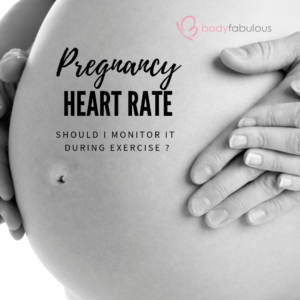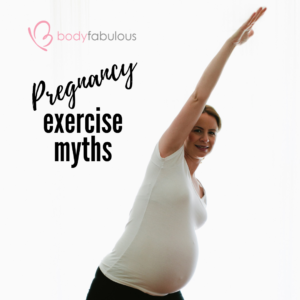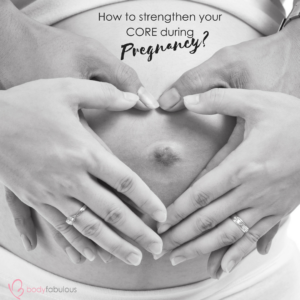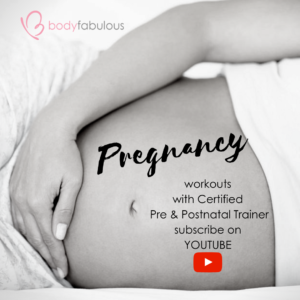There are many suitable exercises to do during pregnancy but there are also several myths about pregnancy fitness. When you become pregnant, it can be overwhelming thinking about exercise as you don’t want to do anything to jeopardise your pregnancy. Especially, if you have taken a long time to conceive, or have had fertility problems. I have 3 children and had a miscarriage in between my 2 boys so I definitely share your concerns.
Safe, effective and appropriate exercises is the all-important focus of all the training I do at Bodyfabulous fitness. Choosing sensible exercise is vital to a healthy and comfortable pregnancy, delivery and post pregnancy outcome. So lets clarify some of the myths and “old wives tales” surrounding exercise during pregnancy.
MYTH 1) You should not exercise when pregnant
Research has shown there are some excellent benefits when exercising during your pregnancy. Women feel less backache, pelvic pain and have a shorter second stage of labour (the worst bit) as well as faster recovery post birth. As a certified pregnancy trainer, I have personally also observed the following with my clients : less swelling, absent pregnant waddle, controlled weight gain, less depression, less back pain, more energy and a fantastic recovery post labour or c-section.
Please always consult your medical practitioner before embarking on any exercise program.
MYTH 2) Women need to rest when pregnant.
Yes if medically they are a risk. Many pregnant women today work and exercise right up until they go into labour. And pregnant women who already have children really don’t get to rest at all, especially if they are chasing after toddlers all day. Exercise however is considered a necessary part of health care; so don’t cease exercise for no particular reason! Not sure where to start ? Grab my FREE fabulous guide to pregnancy exercise.
MYTH 3) Do not raise heart rate above 140 bpm.
This was the so called “safe” level set several years ago however it was removed in 1994 from the ACOG guidelines. Women were told it was unsafe to exercise above this level. This is untrue. Pregnant Women can exercise with a raised heart rate for shorter periods and at lower rates for longer periods.
As a guideline try to aim for 15-20 min of low impact cardio 2-3 times a week and follow the “talk test” – this means you should be able to hold a conversion when exercising.
With regular cardio exercise the size of the placenta increases, and so does its capacity to exchange oxygen and CO2, and nutrients and waste products. Providing amazing nourishment for your baby.
It is also not necessary to wear a heart rate monitor when pregnant and exercising to monitor your exertion. It is much easier to listen to your body for signs of over exertion – these include excess sweating, inability to talk, bright red face, dizziness.
Everyone is different – some women may feel over exerted at 100 bpm while other women who are super fit and have been exercising prior to pregnancy might be fine at 165bpm. So it is important to trust your own response to exercise and know the warning signs when to stop and speak to your trainer or doctor if you have any concerns.
MYTH 4 ) Do not raise arms above head.
Some women believe this will cause record to strangle their baby. Untrue. The position of the cord has nothing to do with the mother’s arm position.
MYTH 5 ) Do not do CORE work / stomach exercises when pregnant
Old wives’ tales say that if you did abdominal exercises you could cause a miscarriage. Untrue. Safe abdominal work is vital for lumbar support, core strength, stability and recovery from abdominal separation.
At Bodyfabulous I only focus on several safe and effective abdominal exercises. Learn more here.
MYTH 6) Do not lift anything heavy when pregnant.
I used free weights plus instructed Les Mills Body Pump throughout all 3 of my pregnancies and found I had all of these benefits. Read more here.
- Control of excessive weight gain.
- Reduced common pregnancy and postnatal discomforts.
- Increase in strength for lifting and carrying your baby and heavy baby-equipment.
- Improvement of overall state of mind during and after pregnancy.
- Strength training helps you cope better with the stress of pregnancy and new motherhood – a new baby is mentally challenging and also very physical work.
Strength training during pregnancy is also excellent to avoid weakening of the following muscles (which is very common during pregnancy) :
- Hamstring; back of the thigh
- Buttocks / Gluteals – important to keep strong to avoid back pain
- Abdominals: more details given above
- Upper back extensors
- Low and mid fibers of the trapezius – near shoulder blades. These muscles are especially needed when you are nursing and holding a baby.
- Squats and lunges, using either your body weight or free weights.
- Both upper- and lower-body cable-pull exercises performed either standing or seated.
- Standing heel rises, employing either your body-weight or free-weights.
- Standing or side-lying leg extensions, using your body weight, resistance bands or tubing, ankle weights, a weighted bar, or similar devices.
- Front, side, and back flies, performed with free weights, resistance bands or tubing.
- Compound rows, done with resistance bands, tubing, or cables.
Subscribe to my YouTube Channel to learn how to do these exercises safely and effectively.

About Dahlas
Dahlas Fletcher is one of Australia’s most respected and successful certified and experienced Pregnancy and Female Fitness Trainers. Her goal is to help you be the happiest, most fabulous version of yourself, inside and out.









